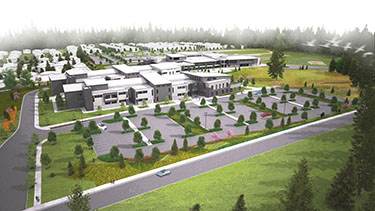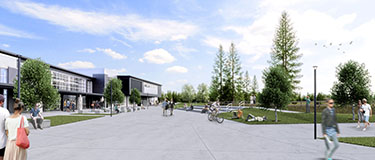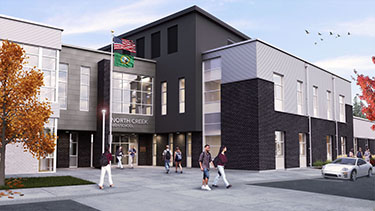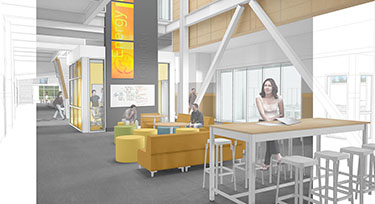|
Subscribe / Renew |
|
|
Contact Us |
|
| ► Subscribe to our Free Weekly Newsletter | |
| home | Welcome, sign in or click here to subscribe. | login |
Construction
| |
 |
August 20, 2015
How to design schools to prepare kids for careers that don’t exist yet
Dykeman

Jewett
|
Designing school buildings was once a largely utilitarian task.
In previous generations, traditional instructional delivery methods consisted of paper textbooks, chalkboards and overhead projectors. Basic education construction was formulaic and catered to these methods, with clusters of isolated classrooms and a separate office building, cafeteria and gym.
Today, educational practices look incredibly different and are constantly evolving. Education now extends beyond the walls of the classroom, collaboration between students is crucial, the paper textbook is on the verge of extinction, and technology is paramount.
Technology has become an integral piece of preparing students for the workforce in an increasingly tech-savvy world.
So how can school districts and architects design schools that prepare kids for careers that don’t even exist yet? How can architects and other professionals design schools that will remain technologically relevant for the next 50 years?
The answer to this lies in the extent of collaboration and visioning that takes place in the pre-design process. Enabling the architect to be an effective partner begins with their inclusion in the project from its inception.
At Dykeman we are currently partnering with Northshore School District on North Creek High School, a new, comprehensive, STEM-focused high school in Bothell, slated to open in the fall of 2017. STEM schools focus on science, technology, engineering and math.
Early conversations
On education projects of this scope, the architect has typically completed approximately 25 percent of the design when educational specifications are drafted, and the architect is invited into the conversation. Northshore School District took a progressive approach, inviting the architect to join their educational task force well ahead of the design process to participate in early conversations about teaching and learning in the 21st century, sustainability, environmental impacts and other factors.
Beginning in 2012, Dykeman participated in a visioning process with a team of school district leadership and representatives from the community, including the Workforce Development Council, Washington STEM, Cascadia Community College, BioQuest and McKinstry.
The goal of the Visioning Team was to engage in comprehensive, exploratory conversations about the connections between instructional program opportunities, facility design and career pathways for future students. “Visioning” consisted of five half-day sessions held over five weeks. With over 30 participants from various segments of the community around the table, the team was able to dialogue in an open and free format — sometimes with significant disagreement — about how K-12 education should be evolving.
These conversations resulted in a clearly distilled vision: North Creek High School would be focused on sustainability, supporting 21st-century learning and beyond, with classrooms extending beyond the building. In addition, a STEM focus would incorporate high-demand fields of study and career opportunities, enabling students to experience real-world application of knowledge and skills.
When architects have a seat at the table from the inception of the visioning process they are able to understand the underlying motivations for various design decisions and are enabled to act as the district’s “right hand” throughout the process. With early involvement comes a clear understanding of a school district’s diverse and unique needs.
On the North Creek High project we have been able to accelerate the design process and remain flexible, collaborative and open to ongoing changes, particularly in response to changing technology and infrastructure. This acceleration, enabled by early partnership, trust and a willingness to remain flexible, is what has truly differentiated this process.
Common spaces
Innovative and early partnership between school districts and architects can positively impact the design in profound ways. In the case of North Creek High, this collaboration has yielded some exciting elements.
First, the common spaces of the school are unique: When you walk into the building, there is a very large, open two-story space. This space contains what we call “collaboration cubes,” and classrooms will open up directly into it and to one another.
The classrooms are not isolated in hallways or sequestered as in the older, more traditional school building designs. The vast space just outside the classroom door will facilitate student and teacher collaboration, allowing projects to be created and displayed collectively.
Flexible furnishings and work areas create “hackable” spaces, yielding student ownership of their own work and educational environment. The design also calls for other numerous student-focused spaces to facilitate community-learning experiences.
The two-story library at North Creek will open up into a large common area, giving students more immediate access to library resources and ensuring that the library is directly integrated into the everyday experiences of students. In addition, the school will be outfitted with an engineering laboratory and a computer lab, with the art wing nestled in close to both to ensure that art and science are integrated.
A wetland is located in the very middle of the school. Instead of turning our backs on this supposedly “unusable” space, it became a focal point of the design.
All buildings look out onto the wetland, and interpretive signage will provide education about wetlands and their importance to the environment. In this way, nature becomes a foundation of the curriculum.
The majority of the classrooms are north facing, creating daylit classrooms with minimal artificial lighting. Combined with a highly efficient building envelope, high-efficiency plumbing fixtures and LED lighting, North Creek is poised to be the most energy-efficient school in Washington state.
Savvy educators understand that effective educational practices rely heavily on collaboration among students. To be effective partners in education design, architects must understand this, too.
Collaboration must be the hallmark of the design partners’ relationship with schools. Together, we can design spaces that surpass the needs of the next generation of learners.
Tim Jewett is the managing principal at Dykeman.
Other Stories:
- Landmark Paul Thiry school reopens to students after 34 years
- Students have their say in Seattle school project
- High-tech tools help contractors keep up as school construction booms
- The grass is actually greener for schools that install synthetic turf
- A ‘third place’: where students can be themselves
- Six trends shaping the future of campus design
- Bellevue College will open its first on-campus housing in 2018
- How to make existing schools healthier, more efficient
- You can have a safe school theater — even on a budget
- New Vancouver high school prepares students for careers in health care






